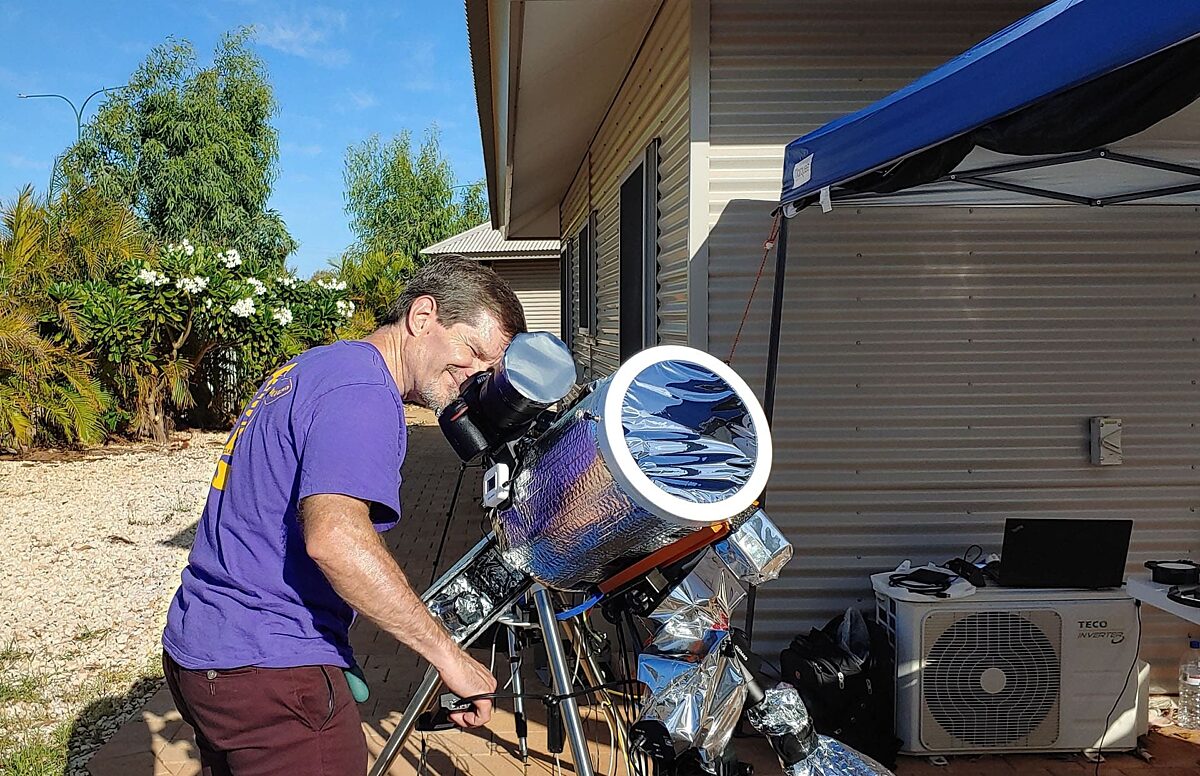Seizing upon syzygy
In terms of sheer cosmic spectacle, it’s hard to beat a total solar eclipse. Watching the Moon blot out the Sun for a few minutes can be a life-changing experience that prompts you to consider your place in space.
For scientists, it’s also a unique opportunity to study the Sun and its effect on our planet. Past eclipses have enabled us to prove Einstein’s theory of general relativity, discover the element helium, uncover sun-grazing comets, and more.
During the April 8, 2024 total solar eclipse, the Moon’s shadow will cross Mexico, the United States, and Canada. More than 43 million people live within the path of totality, and countless more will travel to see it, including scientists who hope to make the most of the moment. We spoke with three solar scientists to learn about their plans for the big event.
A lunar coronagraph
While telescopes and spacecraft can use coronagraphs to block the Sun and reveal the corona, nothing beats the Moon, said Kevin Reardon, a scientist and astronomer at the National Solar Observatory in Boulder, Colorado.
“The Moon remains the best coronagraph because it’s so far away and it’s exactly the right size,” he said. “It blocks the Sun’s light even before it gets to Earth’s atmosphere, making the background very dark. That allows us to see the corona both very close to the Sun and for an extended distance away and make some specific measurements that are only possible during an eclipse.”

Reardon and his colleagues are traveling to Mazatlán, Mexico, for the 2024 eclipse, where the sky will darken for almost four-and-a-half minutes, and chances of clear skies are very high. There, they will set up telescopes equipped with spectrographs that split light into its component wavelengths.
During totality, they will measure the smearing of the solar spectrum caused by the Sun’s light scattering off fast-moving electrons in the corona. This process is related to the Doppler effect — the same phenomenon that makes an ambulance’s siren change in pitch as it passes by. By connecting the amount of smearing to the velocities of the electrons, they can in turn determine the temperatures in the corona.
A longstanding solar science puzzle is why the Sun’s corona is hotter than the surface just a few thousand kilometers below. These temperature measurements will be another step toward solving the mystery.
Reardon said that testing and preparing his equipment to make sure everything works properly can be stressful, but he hopes to have time to steal a glance at the eclipse for himself.
“If all goes well, you can press the button and the equipment will run for part or most of the eclipse by itself, acquiring the data,” he said. “There’s always time to look up and take in the whole spectacle.”
Chasing the shadow
While a solar eclipse is a great opportunity for scientists to study the Sun’s corona, ground-based observers still have to peer through Earth’s atmosphere to make their measurements. Certain studies are difficult or impossible, like observing the Sun in infrared light, since our atmosphere glows at infrared wavelengths.
Fortunately, there’s a solution: fly high-altitude research planes above most of the atmosphere to get a clearer view.
During the 2017 eclipse, Amir Caspi, a principal scientist at the Southwest Research Institute in Boulder, Colorado, led a team that equipped two of NASA’s WB-57 planes with infrared cameras. The two-seater planes, bearing a pilot and an instrument specialist, flew along the path of totality, chasing the eclipse to give them a few extra minutes in the Moon’s shadow.
The result was the highest-resolution image ever captured of the Sun’s corona in medium-wave infrared light. In the image, a solar prominence, a strand of hot gas looping off the Sun’s surface, and an “active region,” a large concentration of magnetic fields from which solar flares often emerge, showed up at the same intensity of infrared light. This was surprising because active regions are much hotter than prominences.
“The intensity in the active region is about the same as the intensity in the prominence, even though they are two orders of magnitude different in temperature,” said Caspi. “So why is that? What is driving the infrared emission for these? That’s what we’re hoping to find out in 2024.”

For the 2024 eclipse, Caspi’s team will once again use a NASA WB-57 that will fly along the eclipse path near Mazatlán, giving them a couple extra minutes in the Moon’s shadow. The plane will be outfitted with a small telescope that feeds four science instruments that will image the Sun’s corona in three different types of infrared light as well as ultraviolet and visible light.
The results may help them determine what is driving the infrared emission in prominences and the corona. They may also learn how much different wavelengths of light coming from prominences and the corona are reflected from the Sun’s surface versus being generated on their own.
The power to educate
A third solar scientist sees the eclipse as a calling to educate and inspire the public.
Maria Kazachenko was a high school student in St. Petersburg, Russia, in 1999. She joined a group of students and teachers for a multiday bus ride across Europe to reach the path of totality for a total solar eclipse crossing Hungary. The experience made a huge impact on her life.

“This experience was so amazing that basically, it was a turning point in my life when I decided to become an astronomer,” she said.
Kazachenko later specialized in solar science. She is now an assistant professor at the Astrophysical & Planetary Science Department at the University of Colorado, Boulder and the National Solar Observatory.
For the 2023 annular eclipse, she traveled to Texas with colleagues for two days of eclipse outreach at local schools and public venues. Her team explained how the Sun works using hands-on experiments and hosted a viewing party for the moment of annularity, where the Moon, slightly too far away from Earth to fully block the Sun, crossed within the Sun’s disk to create a perfect “ring of fire.”
While in her day job as a professor Kazachenko studies solar flares, she has no science scheduled for the 2024 eclipse — instead, she’ll be back in Texas working with the public.
“I feel that going to eclipses and using it as an outreach opportunity is a way for me to give back to the community,” she said. “The experience itself is so amazing that especially if you’re on the path, you cannot miss it.”
The Planetary Report • March Equinox
Help advance space science and exploration! Become a member of The Planetary Society and you'll receive the full PDF and print versions of The Planetary Report.


 Explore Worlds
Explore Worlds Find Life
Find Life Defend Earth
Defend Earth



